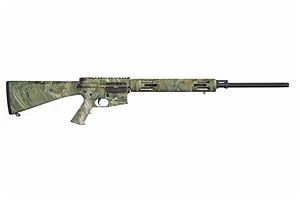Bushmaster Var24 ATACS vs Springfield Armory Model 1873
Put rifles head to head to compare caliber and more.
|
$828.89
|
vs |
$5.00
|
| Rifles | Bushmaster Var24 ATACS | Springfield Armory Model 1873 |
|---|---|---|
| Summary | ||
| Rating | ||
| Rank | ||
| Length | 42.25" | |
| Action | Semi-Automatic | |
| Caliber | .223 Remington | |
| Barrel Length | 24" Heavy Barrel | |
| Capacity | 5 | |
| Finish | Camo | |
| Gun Type | Rifle | |
| Details | ||
| Brand | Bushmaster | Springfield Armory |
| Reviews | See 1 Review | N/A |
| Prices | ||
| MSRP | $816.89 | $6.00 |
| Used Price | $571.82 | $4.20 |
| Sale Price | $735.20 | $5.40 |
Rifles Descriptions
Bushmaster Var24 ATACS
Features a fluted 24 inch chrome-moly steel extra-heavy varmint barrel (one inch diameter out to gas block) and eleven degree competition muzzle crown. Coated bore and chamber. One in nine inch twist free-floated with a vented aluminum fore-end. Two-stage competition trigger (3.5 pound takeup, 1 pound letoff). Ships with manual and 5 round magazine. Covered in A-TACS camouflage finish.
Springfield Armory Model 1873
The Springfield Model 1873 was the Army’s standard issue rifle during the Indian Wars of the 1870s and 1880s. The rifle also saw service in the Spanish-American War and the Philippine Insurrection. Today, it is a favorite weapon of gun collectors. The origins of the M1873 Springfield date back to the waning days of the Civil War. Erskine S. Allin, the master armorer at the Springfield Armory in Massachusetts, was tasked with converting the Army’s muzzle-loading rifles into breech loaders. This resulted in the development of the Model 1865 Springfield, known as “Allin’s Alteration” and later the “Needle Gun” for its long firing pin. The M1865 used a copper-cased cartridge which propelled a .58 caliber bullet with sixty grains of powder. Allin modified his design by lowering the caliber from .58 to .50 after a series of trials in 1866, resulting in the Model 1866. On the frontier, the M1866 performed admirably during several engagements with Indian warriors, and it gained a reputation as a dependable firearm. However, there were flaws in its design, most notably, the breech block tended to swing open when under pressure. Eager to correct this flaw, the Ordnance Department began a series of trials to find a suitable replacement to the M1866.



